Economic Analysis Report: Tertiary Education Market Impacts
VerifiedAdded on 2020/01/07
|5
|904
|158
Report
AI Summary
This report provides an economic analysis of the tertiary education market, examining the impact of price ceilings and deregulation. It begins with an introduction to economic analysis and its role in policy design, then delves into the market dynamics of tertiary education, including supply and demand changes under different conditions. The analysis explores the effects of price ceilings on surplus, literacy rates, and the potential for black markets. Furthermore, the report investigates the impact of deregulation on efficiency and equity within the education system. The report includes a detailed discussion of the market before and after deregulation, and concludes with a summary of key findings and a list of references. The report aims to provide a comprehensive understanding of the economic factors influencing tertiary education and their implications for policy decisions.
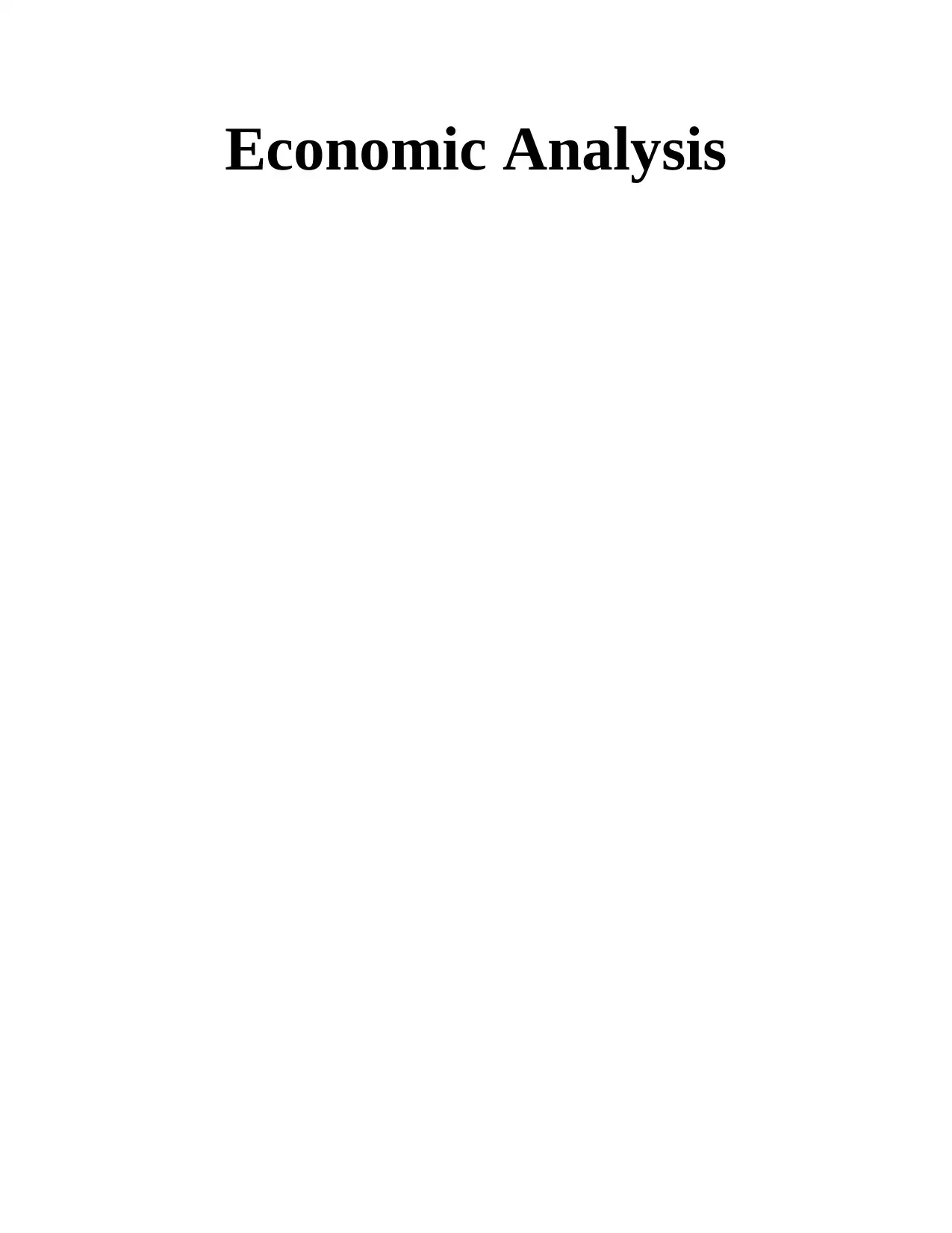
Economic Analysis
Paraphrase This Document
Need a fresh take? Get an instant paraphrase of this document with our AI Paraphraser
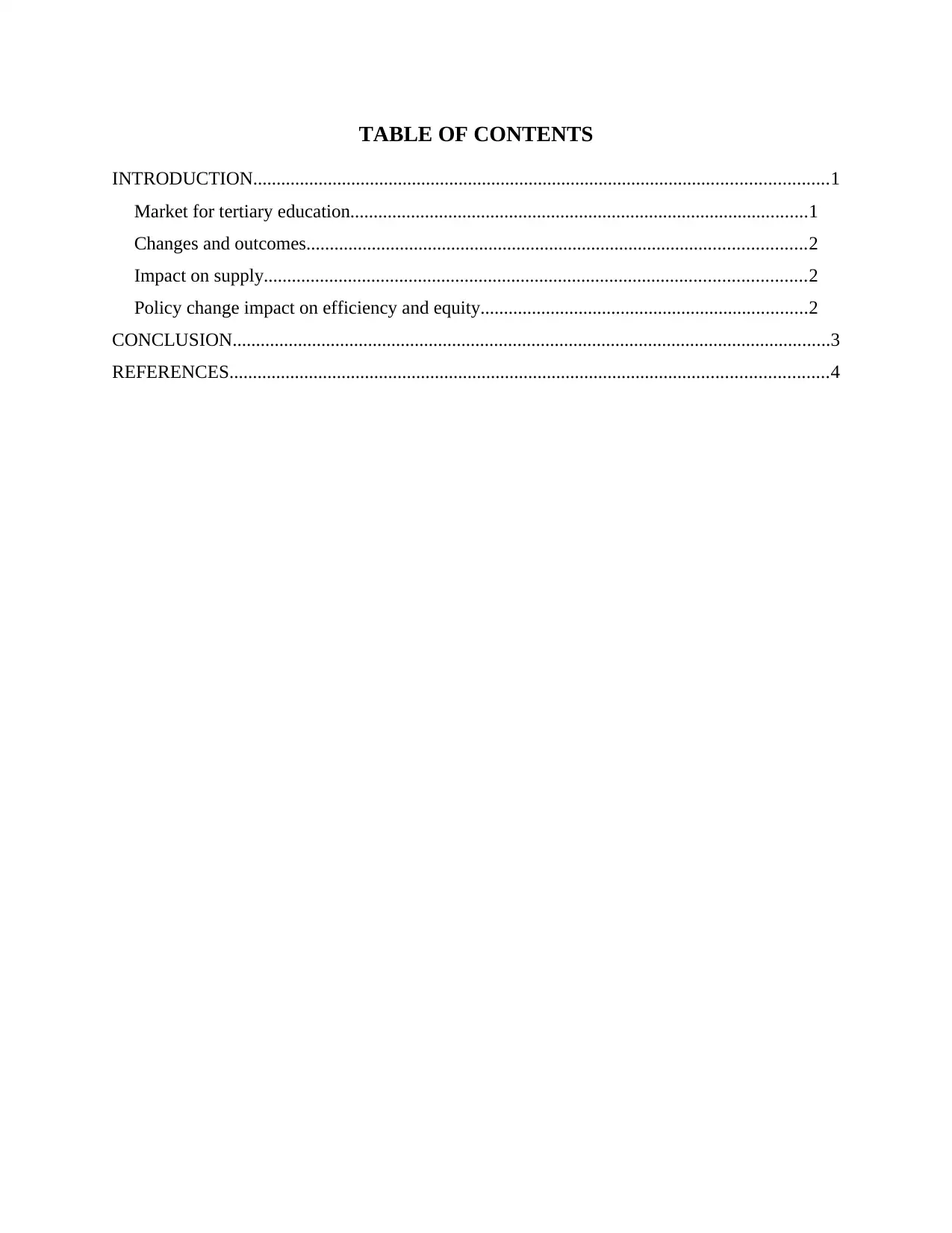
TABLE OF CONTENTS
INTRODUCTION...........................................................................................................................1
Market for tertiary education..................................................................................................1
Changes and outcomes...........................................................................................................2
Impact on supply....................................................................................................................2
Policy change impact on efficiency and equity......................................................................2
CONCLUSION................................................................................................................................3
REFERENCES................................................................................................................................4
INTRODUCTION...........................................................................................................................1
Market for tertiary education..................................................................................................1
Changes and outcomes...........................................................................................................2
Impact on supply....................................................................................................................2
Policy change impact on efficiency and equity......................................................................2
CONCLUSION................................................................................................................................3
REFERENCES................................................................................................................................4
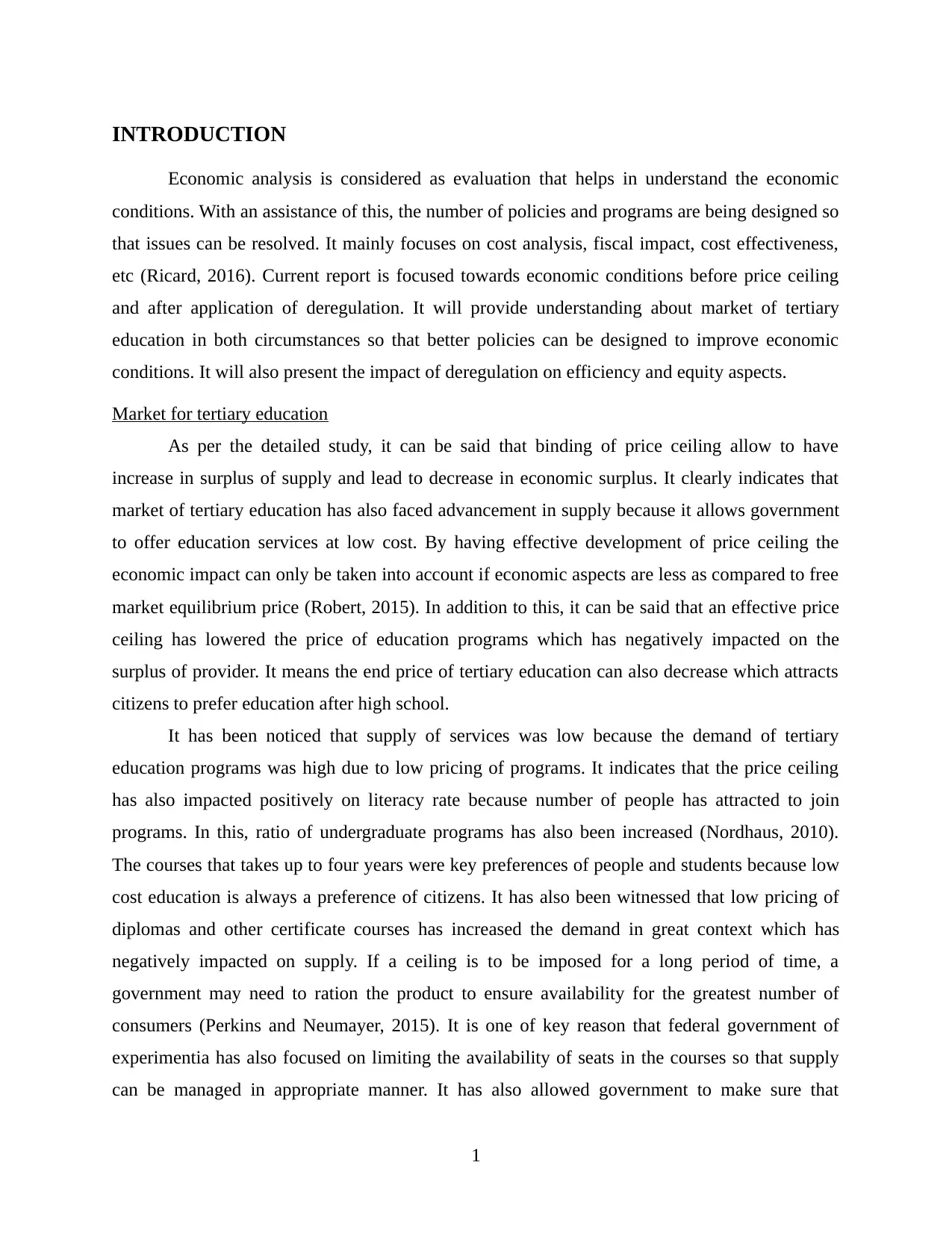
INTRODUCTION
Economic analysis is considered as evaluation that helps in understand the economic
conditions. With an assistance of this, the number of policies and programs are being designed so
that issues can be resolved. It mainly focuses on cost analysis, fiscal impact, cost effectiveness,
etc (Ricard, 2016). Current report is focused towards economic conditions before price ceiling
and after application of deregulation. It will provide understanding about market of tertiary
education in both circumstances so that better policies can be designed to improve economic
conditions. It will also present the impact of deregulation on efficiency and equity aspects.
Market for tertiary education
As per the detailed study, it can be said that binding of price ceiling allow to have
increase in surplus of supply and lead to decrease in economic surplus. It clearly indicates that
market of tertiary education has also faced advancement in supply because it allows government
to offer education services at low cost. By having effective development of price ceiling the
economic impact can only be taken into account if economic aspects are less as compared to free
market equilibrium price (Robert, 2015). In addition to this, it can be said that an effective price
ceiling has lowered the price of education programs which has negatively impacted on the
surplus of provider. It means the end price of tertiary education can also decrease which attracts
citizens to prefer education after high school.
It has been noticed that supply of services was low because the demand of tertiary
education programs was high due to low pricing of programs. It indicates that the price ceiling
has also impacted positively on literacy rate because number of people has attracted to join
programs. In this, ratio of undergraduate programs has also been increased (Nordhaus, 2010).
The courses that takes up to four years were key preferences of people and students because low
cost education is always a preference of citizens. It has also been witnessed that low pricing of
diplomas and other certificate courses has increased the demand in great context which has
negatively impacted on supply. If a ceiling is to be imposed for a long period of time, a
government may need to ration the product to ensure availability for the greatest number of
consumers (Perkins and Neumayer, 2015). It is one of key reason that federal government of
experimentia has also focused on limiting the availability of seats in the courses so that supply
can be managed in appropriate manner. It has also allowed government to make sure that
1
Economic analysis is considered as evaluation that helps in understand the economic
conditions. With an assistance of this, the number of policies and programs are being designed so
that issues can be resolved. It mainly focuses on cost analysis, fiscal impact, cost effectiveness,
etc (Ricard, 2016). Current report is focused towards economic conditions before price ceiling
and after application of deregulation. It will provide understanding about market of tertiary
education in both circumstances so that better policies can be designed to improve economic
conditions. It will also present the impact of deregulation on efficiency and equity aspects.
Market for tertiary education
As per the detailed study, it can be said that binding of price ceiling allow to have
increase in surplus of supply and lead to decrease in economic surplus. It clearly indicates that
market of tertiary education has also faced advancement in supply because it allows government
to offer education services at low cost. By having effective development of price ceiling the
economic impact can only be taken into account if economic aspects are less as compared to free
market equilibrium price (Robert, 2015). In addition to this, it can be said that an effective price
ceiling has lowered the price of education programs which has negatively impacted on the
surplus of provider. It means the end price of tertiary education can also decrease which attracts
citizens to prefer education after high school.
It has been noticed that supply of services was low because the demand of tertiary
education programs was high due to low pricing of programs. It indicates that the price ceiling
has also impacted positively on literacy rate because number of people has attracted to join
programs. In this, ratio of undergraduate programs has also been increased (Nordhaus, 2010).
The courses that takes up to four years were key preferences of people and students because low
cost education is always a preference of citizens. It has also been witnessed that low pricing of
diplomas and other certificate courses has increased the demand in great context which has
negatively impacted on supply. If a ceiling is to be imposed for a long period of time, a
government may need to ration the product to ensure availability for the greatest number of
consumers (Perkins and Neumayer, 2015). It is one of key reason that federal government of
experimentia has also focused on limiting the availability of seats in the courses so that supply
can be managed in appropriate manner. It has also allowed government to make sure that
1
⊘ This is a preview!⊘
Do you want full access?
Subscribe today to unlock all pages.

Trusted by 1+ million students worldwide
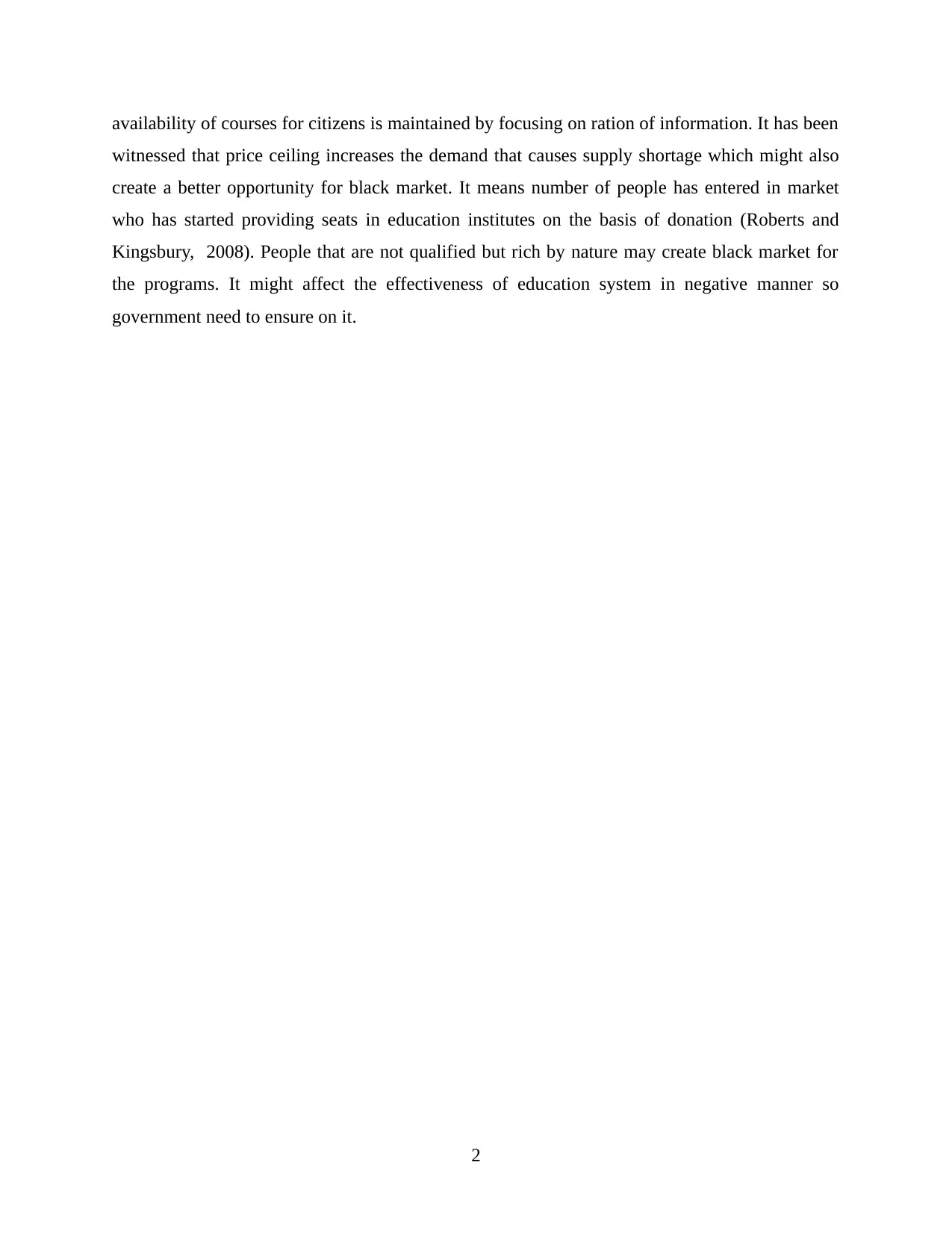
availability of courses for citizens is maintained by focusing on ration of information. It has been
witnessed that price ceiling increases the demand that causes supply shortage which might also
create a better opportunity for black market. It means number of people has entered in market
who has started providing seats in education institutes on the basis of donation (Roberts and
Kingsbury, 2008). People that are not qualified but rich by nature may create black market for
the programs. It might affect the effectiveness of education system in negative manner so
government need to ensure on it.
2
witnessed that price ceiling increases the demand that causes supply shortage which might also
create a better opportunity for black market. It means number of people has entered in market
who has started providing seats in education institutes on the basis of donation (Roberts and
Kingsbury, 2008). People that are not qualified but rich by nature may create black market for
the programs. It might affect the effectiveness of education system in negative manner so
government need to ensure on it.
2
Paraphrase This Document
Need a fresh take? Get an instant paraphrase of this document with our AI Paraphraser
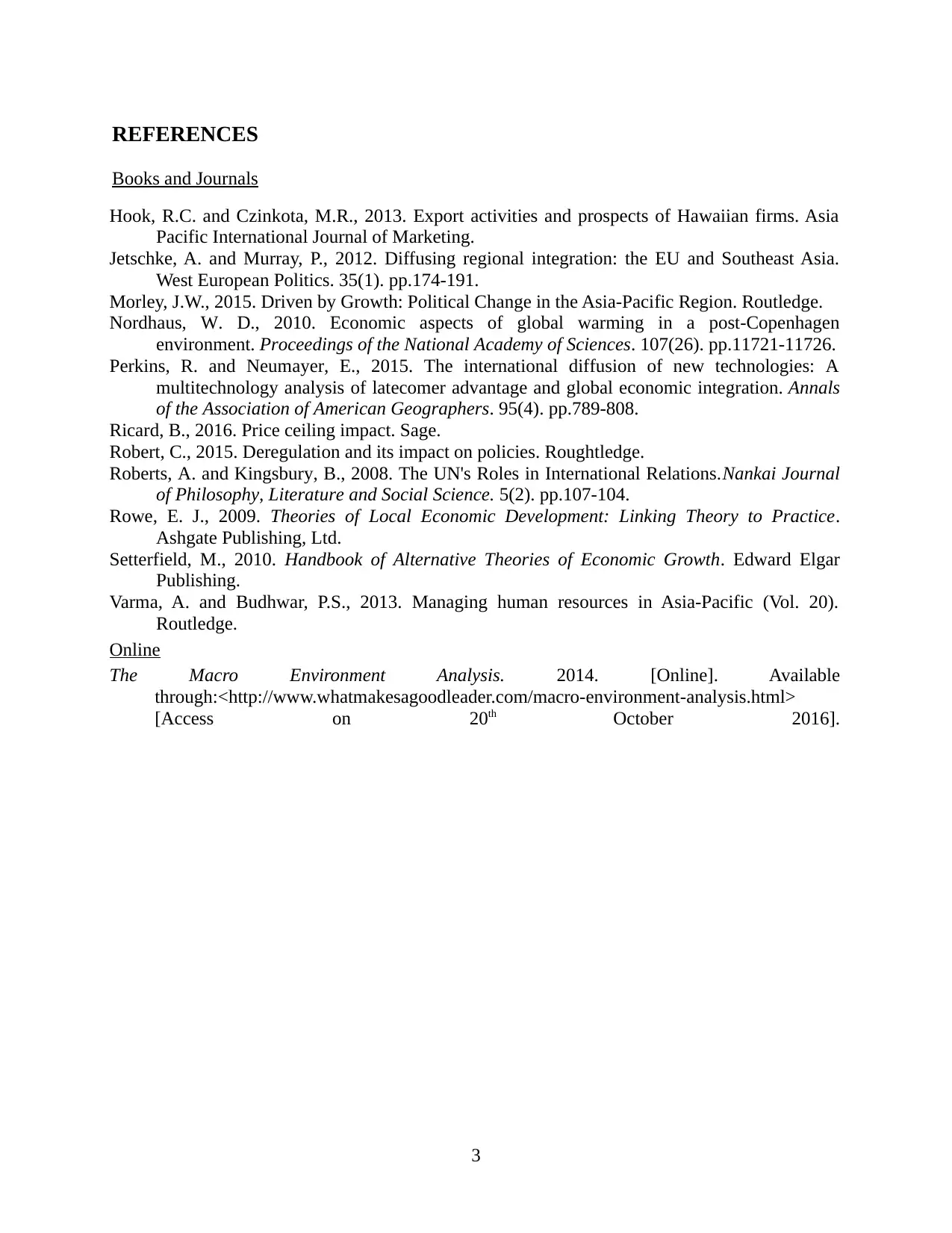
REFERENCES
Books and Journals
Hook, R.C. and Czinkota, M.R., 2013. Export activities and prospects of Hawaiian firms. Asia
Pacific International Journal of Marketing.
Jetschke, A. and Murray, P., 2012. Diffusing regional integration: the EU and Southeast Asia.
West European Politics. 35(1). pp.174-191.
Morley, J.W., 2015. Driven by Growth: Political Change in the Asia-Pacific Region. Routledge.
Nordhaus, W. D., 2010. Economic aspects of global warming in a post-Copenhagen
environment. Proceedings of the National Academy of Sciences. 107(26). pp.11721-11726.
Perkins, R. and Neumayer, E., 2015. The international diffusion of new technologies: A
multitechnology analysis of latecomer advantage and global economic integration. Annals
of the Association of American Geographers. 95(4). pp.789-808.
Ricard, B., 2016. Price ceiling impact. Sage.
Robert, C., 2015. Deregulation and its impact on policies. Roughtledge.
Roberts, A. and Kingsbury, B., 2008. The UN's Roles in International Relations.Nankai Journal
of Philosophy, Literature and Social Science. 5(2). pp.107-104.
Rowe, E. J., 2009. Theories of Local Economic Development: Linking Theory to Practice.
Ashgate Publishing, Ltd.
Setterfield, M., 2010. Handbook of Alternative Theories of Economic Growth. Edward Elgar
Publishing.
Varma, A. and Budhwar, P.S., 2013. Managing human resources in Asia-Pacific (Vol. 20).
Routledge.
Online
The Macro Environment Analysis. 2014. [Online]. Available
through:<http://www.whatmakesagoodleader.com/macro-environment-analysis.html>
[Access on 20th October 2016].
3
Books and Journals
Hook, R.C. and Czinkota, M.R., 2013. Export activities and prospects of Hawaiian firms. Asia
Pacific International Journal of Marketing.
Jetschke, A. and Murray, P., 2012. Diffusing regional integration: the EU and Southeast Asia.
West European Politics. 35(1). pp.174-191.
Morley, J.W., 2015. Driven by Growth: Political Change in the Asia-Pacific Region. Routledge.
Nordhaus, W. D., 2010. Economic aspects of global warming in a post-Copenhagen
environment. Proceedings of the National Academy of Sciences. 107(26). pp.11721-11726.
Perkins, R. and Neumayer, E., 2015. The international diffusion of new technologies: A
multitechnology analysis of latecomer advantage and global economic integration. Annals
of the Association of American Geographers. 95(4). pp.789-808.
Ricard, B., 2016. Price ceiling impact. Sage.
Robert, C., 2015. Deregulation and its impact on policies. Roughtledge.
Roberts, A. and Kingsbury, B., 2008. The UN's Roles in International Relations.Nankai Journal
of Philosophy, Literature and Social Science. 5(2). pp.107-104.
Rowe, E. J., 2009. Theories of Local Economic Development: Linking Theory to Practice.
Ashgate Publishing, Ltd.
Setterfield, M., 2010. Handbook of Alternative Theories of Economic Growth. Edward Elgar
Publishing.
Varma, A. and Budhwar, P.S., 2013. Managing human resources in Asia-Pacific (Vol. 20).
Routledge.
Online
The Macro Environment Analysis. 2014. [Online]. Available
through:<http://www.whatmakesagoodleader.com/macro-environment-analysis.html>
[Access on 20th October 2016].
3
1 out of 5
Related Documents
Your All-in-One AI-Powered Toolkit for Academic Success.
+13062052269
info@desklib.com
Available 24*7 on WhatsApp / Email
![[object Object]](/_next/static/media/star-bottom.7253800d.svg)
Unlock your academic potential
Copyright © 2020–2025 A2Z Services. All Rights Reserved. Developed and managed by ZUCOL.





